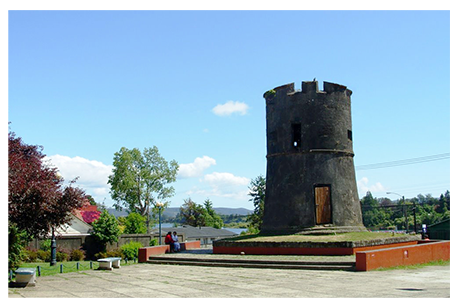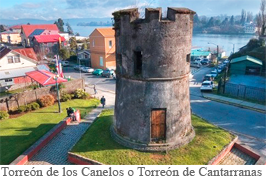Spanish Towers in Valdivia
Description: The Tower El Barro and the Tower Los Canelos are an attraction of great interest since they are the only standing remnants of the old Spanish fort system in Valdivia. 
Testimony of the Spanish colonial period these were built to serve as defense and protection for the entrance and exit to the city. The Tower El Barro is located at the intersection of Picarte Avenue and Condell Street and the Tower Los Canelos is at the intersection of Yungay Street and Yerbas Buenas Street. On Yungay street, from the tower onwards you may see the German influence on the old houses that still endure today.
The Tower El Barro, also called Tower Picarte is a historical monument in the city of Valdivia, Los Ríos Region, Chile. It is located in one of the ancient entrances to the city —the way to Los Llanos— and was projected together with the Tower Los Canelos in 1678 by the engineer John Garland; its execution was performed by the Governor Joaquin Espinoza y Dávalos in 1774.
The Tower Los Canelos or Cantarranas is another historical monument in the city of Valdivia, Los Ríos Region, Chile. It was also designed in 1678 by the engineer John Garland as part of an infrastructure network of defense to counter the Indian attack in Valdivia; his work was also executed by the Governor Joaquin Espinoza y Dávalos in 1774.
Both towers belong to the set of National Monuments of Chile since 1926 by Presidential Decree 744 issued on March 24 of that year, both of them are structures in the category of "Historial Monuments".
History: After the Battle of Curalaba in 1598, Valdivia was destroyed by the Huilliche population in November of 1599. Following this, a Dutch expedition led by Hendrick Brouwer formed an alliance with the indigenous Huilliches from the Chacao channel against the Spanish settlers of Chiloé, the same strategy employed when they reached the Corral Bay in 1643, but eventually they withdrew from the area.
During the seventeenth century, the settlement of Valdivia was the best fortified city of the Spanish colonial domain, due to its strategic importance. The Spanish repopulation began in February 1645, it was a gradual process until in 1684 the city was re-established in its original site; however, the surroundings were still controlled by the Lafkenche-Huilliche people.
 Both Valdivia and Chiloé Archipelago represented the southernmost enclaves of the Pacific coast, and their strategic importance to the Viceroyalty of Peru made it necessary to fortify them to avoid the attack of the indigenous population; thus, in that sense the engineer Juan Garland projected a defense network for Valdivia, in 1678, which included both towers.
Both Valdivia and Chiloé Archipelago represented the southernmost enclaves of the Pacific coast, and their strategic importance to the Viceroyalty of Peru made it necessary to fortify them to avoid the attack of the indigenous population; thus, in that sense the engineer Juan Garland projected a defense network for Valdivia, in 1678, which included both towers.
Hence, the construction of the towers would be executed by the Governor Joaquin Espinoza y Dávalos in 1774. In 1781 they were included by Antonio Duce Oliveros within the defense system of the city for the impending war with England (years 1780-1799). On February 15, 1785, the Tower Picarte became the prison of Thomas Figueroa after being accused by the governor of the time as "arsonist".
The towers are the only remnants that remain standing from the old fortifications of Valdivia. The city, founded in 1552 by Pedro de Valdivia, was devastated by the native uprising occurred in the late sixteenth century. During the seventeenth century, the Viceroy of Peru Antonio de Toledo, sent an army of 900 men, supplies, and a large amount of construction materials, to meet two objectives: to refound the city of Valdivia and to establish fortifications in the area, particularly in the mouth of the Valdivia river. These objectives were high priority for the Spanish Crown, given the strategic character of the place. It was necessary for the imperial sovereignty to maintain well defended this coastal area, exposed to the ambitions of rival powers (England, Holland, France), who had already attempted incursions by various expeditions.
The task assumed by the Viceroy Toledo led to the creation of the largest stronghold of the American Pacific coast, comprising a set of fortifications including the forts of Corral and Niebla, the Castle of San Luis de Alba and the Castle of San Pedro of Amargos, among others. With regard to Valdivia, in addition to the refounding of the city, the navy sent by the Viceroy proceeded also to fortify its defense with cob walls, which later would be replaced by stone. It is however in the eighteenth century when the fortification plan of Valdivia reaches its full implementation, under a comprehensive plan developed by the engineer John Garland. An important part of this plan was the construction of two towers, that the Governor Joaquin Espinoza executed in 1774 under the threat posed not so much by the European rivals but by the natives of the area.
In 1774 the Governor commissioned the construction of both towers to guard the two only entry points to the city at that time, thus serving as the only entrance and exit of the city. They were originally designed to divert the river, transforming the end of the city into an island. In its construction bricks from the royal brick and tile factory were employed, located somewhere in the current Teja Island. A system of defensive walls together with the tower ended in a wide rake-like grate and drawbridge.
The towers are cylindrical in shape and were built with brick and lime; the walls have a thickness of 60 cm at the base and 30 centimeters at the top. The structures were designed to serve as watchtowers or viewpoints; however, they were also used as dungeons, powder magazine and windmills. The construction of these defenses was very frustrating for Espinoza, who was questioned by the alleged uselessness of these structures.
Fortresses and castles were mainly designed by the most relevant engineers of the Royal Crown, reflecting a process of cultural and technological influence transferred to America. These valuable remains, which represent the genesis of the urban settlement logic in our country, are partially protected, and administrated by governmental entities. The strong historical significance of these manifestations of the Spanish colonial process has to be understood as part of a fortification system in the New World. The Spanish colonial process in Chile took place mainly inland, establishing only three main strongly fortified coastal areas in Valparaiso, Valdivia and Punta Arenas. Valdivia is the oldest southern city founded, today it has an industrial character and has become a university pole and tourist attraction.
They have been well preserved.
Activities: Walk, photography, visit to historical site.



